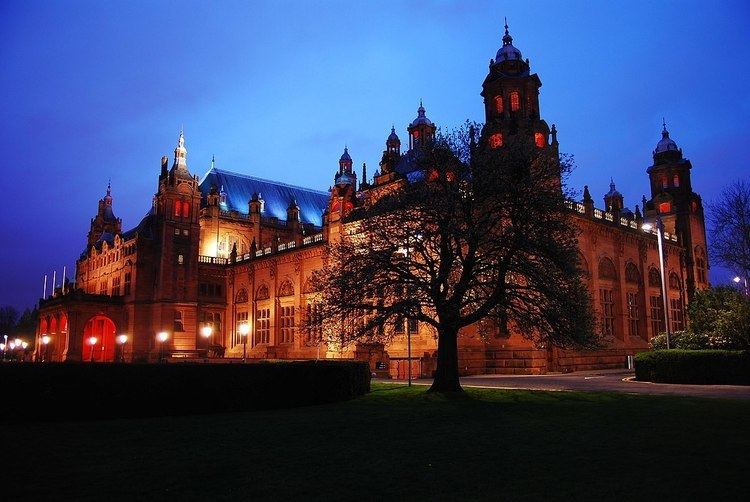Established 1901 Website www.glasgowlife.org.uk | Collection size 9,000 objects Opened 2 May 1901 | |
 | ||
Visitors 1,261,552 (2015)Admission type: FreeRanked 13th nationallyRanked 60th globally Address Argyle St, Glasgow G3 8AG, UK Hours Closed now Saturday10AM–5PMSunday11AM–5PMMonday10AM–5PMTuesday10AM–5PMWednesday10AM–5PMThursday10AM–5PMFriday11AM–5PM Artwork Arrangement in Grey and Black, No. 2: Portrait of Thomas Carlyle, Oh ye, all ye that walk in Willowood Architects John William Simpson, Edmund John Milner Allen Similar Burrell Collection, Glasgow Science Centre, Glasgow Botanic Gardens, Glasgow Necropolis, Glasgow Green | ||
Kelvingrove art gallery and museum
The Kelvingrove Art Gallery and Museum is a museum and art gallery in Glasgow, Scotland. It reopened in 2006 after a three-year refurbishment and since then has been one of Scotland's most popular visitor attractions.
Contents
The gallery is located on Argyle Street, in the West End of the city, on the banks of the River Kelvin (opposite the architecturally similar Kelvin Hall, which was built in matching style in the 1920s, after the previous hall had been destroyed by fire). It is adjacent to Kelvingrove Park and is situated near the main campus of the University of Glasgow on Gilmorehill.
Kelvingrove art gallery and museum
Design and construction
The construction of Kelvingrove was partly financed by the proceeds of the 1888 International Exhibition held in Kelvingrove Park. The gallery was designed by Sir John W. Simpson and E.J. Milner Allen and opened in 1901, as the Palace of Fine Arts for the Glasgow International Exhibition held in that year. It is built in a Spanish Baroque style, follows the Glaswegian tradition of using Locharbriggs red sandstone, and includes an entire program of architectural sculpture by George Frampton, William Shirreffs, Francis Derwent Wood and other sculptors.
The centrepiece of the Centre Hall is a concert pipe organ constructed and installed by Lewis & Co. The organ was originally commissioned as part of the Glasgow International Exhibition, held in Kelvingrove Park in 1901. The organ was installed in the concert hall of the exhibition, which was capable of seating 3,000 people. The Centre Hall of the then newly completed Art Gallery and Museum was intended from the beginning to be a space in which to hold concerts. When the 1901 exhibition ended, a Councillor urged the Glasgow Corporation (now Glasgow Council) to purchase the organ, stating that without it, "the art gallery would be a body without a soul". Purchase price and installation costs were met from the surplus exhibition proceeds, and the organ was installed in the Centre Hall by Lewis and Co. The present case front in walnut with non-functional display pipes was commissioned at this time from John W. Simpson. Simpson was the senior partner of Simpson & Milner Allen, architects of the gallery building.
There is a popular myth in Glasgow, that the building was accidentally built back-to-front, and the architect jumped from one of the towers in despair, when he realised his mistake. This is only an urban myth. The grand entrance was always intended to face into Kelvingrove Park.
Collections
The museum's collections came mainly from the McLellan Galleries and from the old Kelvingrove House Museum in Kelvingrove Park. It has one of the finest collections of arms and armour in the world and a vast natural history collection. The art collection includes many outstanding European artworks, including works by the Old Masters (Rembrandt van Rijn, Gerard de Lairesse, and Jozef Israëls), French Impressionists (such as Claude Monet, Pierre-Auguste Renoir, Camille Pissarro, Vincent van Gogh and Mary Cassatt), Dutch Renaissance, Scottish Colourists and exponents of the Glasgow School.
The museum houses Christ of Saint John of the Cross by Salvador Dalí. The copyright of this painting was bought by the curator at the time after a meeting with Dalí himself. For a period between 1993 and 2006, the painting was moved to the St Mungo Museum of Religious Life and Art.
The museum also contains a large gift of the decorative arts from Anne Hull Grundy, an art collector and philanthropist, covering the history of European jewellery in the 18th and 19th centuries.
Refurbishment
Kelvingrove was reopened by Her Majesty Queen Elizabeth II on 11 July 2006 after a three-year closure for major refurbishment and restoration. The work cost around £28 million and includes a new restaurant and a large basement extension to its display space to accommodate the 8,000 exhibits now on display. A new display layout and wayfinding scheme was introduced to make the building more visitor-friendly.
Immediately after its 2003–06 refurbishment, the museum was the most popular free-to-enter visitor attraction in Scotland, recording 2.23 million visitors in 2007. These numbers made it the most visited museum in the United Kingdom outside London. In 2015 there were 1,261,552 visitors.
